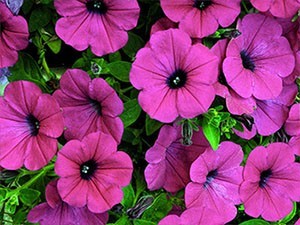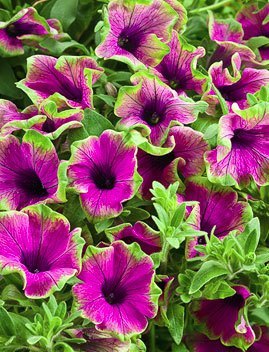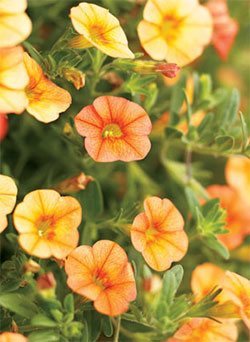Petunias have been the summer color annual of choice in gardens for more than a century. The frilly flowers are reliably beautiful in baskets, containers, window boxes and as ground cover in sunny garden beds, and they have lovely fragrance too.
Popular and easy-to-grow new varieties
Exciting new petunias have been coming from plant breeders’ magic wands with luscious colors, several flower sizes, and flowing growth habits. They are also bred to be self-cleaning and more weather resistant, which makes them a great improvement over the old floribunda types that needed constant deadheading to look nice.

One of the original favorites: Purple Wave
Wave series: You can’t beat the Wave series (Tidal Waves, Shock Waves and Easy Waves) for blanketing the ground in a hurry.
Purple, pink, rose or lilac flowers smother the spreading plants all summer long.
If weather stress has them looking a bit shaggy, a quick prune will have them off and running once again.

Supertunia ®Pretty Much Picasso
Photo: Proven Winners
Supertunias: These types are the best choice for sunny containers and window boxes.
These beauties are bred to spill out of their containers and vine as long as 3 feet, even in the short growing season areas.
Colors include white, pink, red, deep purple, salmon coral and yellow.
A new hot number is Supertunia ‘Pretty Much Picasso’, a smallish purple-violet flower with lime green edges that match the green of the foliage. The flowering is dense and non-stop.

Superbells ®Dreamsicle Calibrachoa
Photo: Proven Winners
Million Bells (Calibrachoa) and Super Bells: These lovely annuals are tiny look-alikes with sheets of flowers only 1 inch across.
They spill over containers or spread in ground beds with the added advantage of self-cleaning – old flowers fade and fall off so there is no need to dead-head.
The color range is large: pink, white, blue, red, salmon and terra cotta.
Be sure to use an acid (peat-based) potting soil with Million Bells plants to avoid yellow foliage that occurs when soil pH rises above 6.0.
If the water in your area has a high calcium content, use quarter strength soluble fertilizer for acid-loving plants at least weekly.
Petunia planting and care tips
When to plant: All petunias and calibrachoas are tropical, so don’t plant them out until the weather is settled enough to plant tomatoes – in other words, until all danger of frost is over for the season.
Light requirements: These annuals need 6 hours of full sun each day for maximum performance.
Water: The hard and fast rule to keep them going all summer is regular watering and fertilization. Keep the plants moist, but not wet.
Fertilizer: These plants are heavy feeders and they will reward you with lots of flowers if you regularly provide them with liquid flowering plant fertilizer. Feed plants in containers once a week and every two weeks for plants in the ground.
Grooming: If the plants get a bit straggly, which can happen in mid- to late summer, particularly with vining types, just cut them back and give them a boost with fertilizer, and they should rally.
With this treatment – regular watering and fertilizing and occasional cutting back – your petunias and calibrachoas will overflow with brilliant blooms from late spring right up to frost.
Related information
Sunflowers for your summer garden
Container gardening tips: A great way to grow annuals




